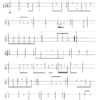Introduction
The Sarabande by Johann Sebastian Bach is a deeply emotional and reflective dance movement, often considered one of the most expressive pieces in the Baroque repertoire. Typically part of his suites for keyboard, cello, or lute, the Sarabande showcases Bach’s ability to transform a traditional dance form into a profound musical statement. Written in a slow triple meter, the piece features a flowing melody interwoven with rich harmonic progressions, creating a meditative atmosphere.
While the Sarabande adheres to the dance’s traditional structure, Bach imbues it with unmatched depth and emotional resonance. On classical guitar, the piece requires a balance of technical precision and musical sensitivity. The guitarist must focus on the phrasing, dynamics, and tonal variation to capture the piece’s introspective character. The Sarabande’s timeless appeal lies in its ability to convey universal emotions, making it a favourite among performers and audiences alike.
Musical Style
Bach’s musical style is characterised by its complexity, elegance, and timeless beauty. As a master of counterpoint, he often created intricate interweaving melodies that work harmoniously within structured forms. Bach’s music balances technical rigour with expressive depth, offering a perfect blend of intellectual and emotional appeal. His works reflect a deep understanding of harmony, melody, and rhythm, often pushing the boundaries of the Baroque style. Influenced by German, Italian, and French traditions, Bach’s compositions seamlessly incorporate these elements, creating a unique and universal language. His legacy continues to influence musicians across genres, standing as a pinnacle of Western classical music.
Notable Pieces
Five notable pieces by Johann Sebastian Bach
•Brandenburg Concertos
•Goldberg Variations
•The Well-Tempered Clavier
•Cello Suites
•St. Matthew Passion







Reviews
There are no reviews yet.